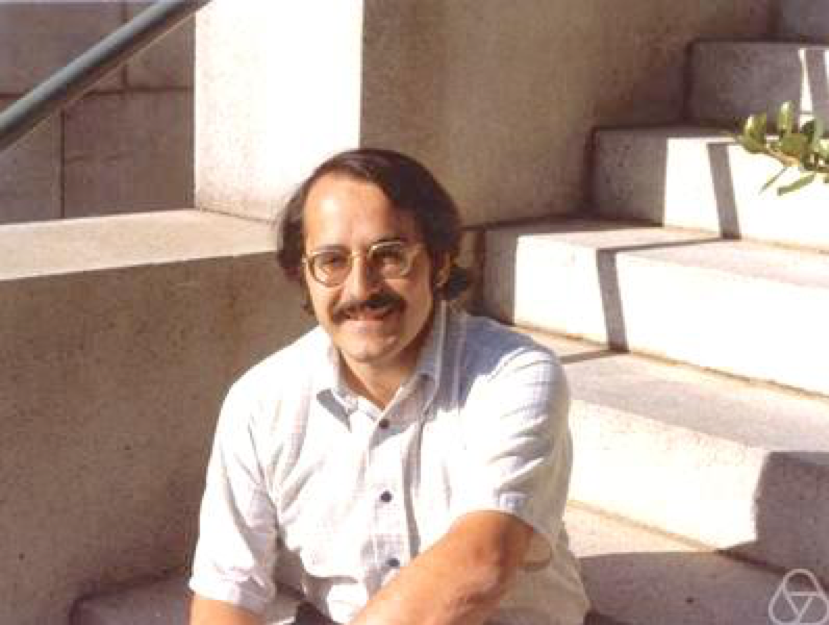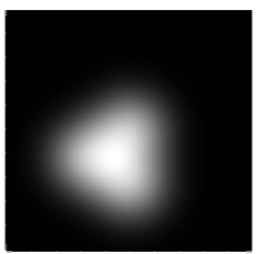
ARC Inventor Peter M. Goorjian

Figure 1: Space Optical Communications using a Lens System with a Vertical Cavity Surface Emitting Laser (VCSEL)/ Photodetector Array.

Figure. 2: Irradiance of three overlapping laser beams after 500 Km of propagation from LEO. Computational results.
I am a computer engineer in the NASA Advanced Supercomputing (NAS) Division at NASA Ames Research Center (ARC). In my 43 years of experience at Ames, I’ve been developing and applying numerical algorithms and computer simulations with applications to aircraft and spacecraft –specifically in aerodynamics, aero-elasticity, radar cross section, nonlinear optics, lasers, and space laser communications. My work has been recognized through various awards and publications.
I have authored over 100 publications and have received the Jack N. Nielsen award for computational modeling of all-optical switches. I have a B.S. in physics and mathematics (1962), a M.S. in physics (1964) and a Ph.D in mathematics (1969), from the University of California, Berkeley. I am also a member of the Optical Society of America.
What does this invention do?
Space Optical Communications Using Laser Beams provides a new method for optical data transmissions from satellites using laser arrays for laser beam pointing and provides an accurate Pointing, Acquisition, and Tracking (PAT). This simple, static, and compact, technology combines a lens system and a vertical-cavity surface-emitting laser (VCSEL)/Photodetector Array, both mature technologies, in a novel way for PAT.
It can improve the PAT system’s size, weight, and power (SWaP) in comparison to current systems. Preliminary analysis indicates that this system is applicable to transmissions between satellites in low-Earth orbit (LEO) and ground terminals. Computer simulations using this design have been made for the application of this innovation to a CubeSat in LEO. The computer simulations included modeling the laser source and diffraction effects due to wave optics.
The pointing used a diffraction limited lens system and a VCSEL array. These capabilities make it possible to model laser beam propagation over long space communication distances.
What problem does this technology solve?
Laser beam pointing is very challenging for LEO, including science missions. Current architectures use dynamical systems, (i.e., moving parts, e.g., fast-steering mirrors (FSM), and/or gimbals) to turn the laser to point to the ground terminal, and some use vibration isolation platforms as well. These dynamical systems could be replaced with the static system described in this patent.
For these electro-optical systems, reaction times to pointing changes and vibrations are on the nanosecond time scale, much faster than those for mechanical systems. For LEO terminals, slew rates are not a concern with this new system.
Who else might benefit from this technology? What other applications do you envision?
Possible additional applications are to planetary distances (deep space optical communications (DSOC)), to optical multiple access (OMA), to communication between a constellation of close satellites, and to satellites that use modulating retro-reflectors. Another possible application is to the Artemis Program for CubeSats in LLO.
Do you have any future plans to continue development of this technology?
Yes. I am continuing to develop this system for pointing laser beams for space optical communications, both to improve the design and to apply it to communications beyond LEO. Also I have plans to start laboratory development of components with university collaborators and I am seeking funds from NASA headquarters for that work.
Whom should I contact if I want to know more about this technology?
For additional information on this NASA technology contact the Ames Tech Transfer Office .
Learn more about this technology here.
For more information:
U.S. Patent No. 9,774,395, Space Optical Communications Using Laser Beams, September 26, 2017.
U.S. Patent No. 9,954,613, Methods and Devices for Space Optical Communications Using Laser Beams, April 24, 2018.



